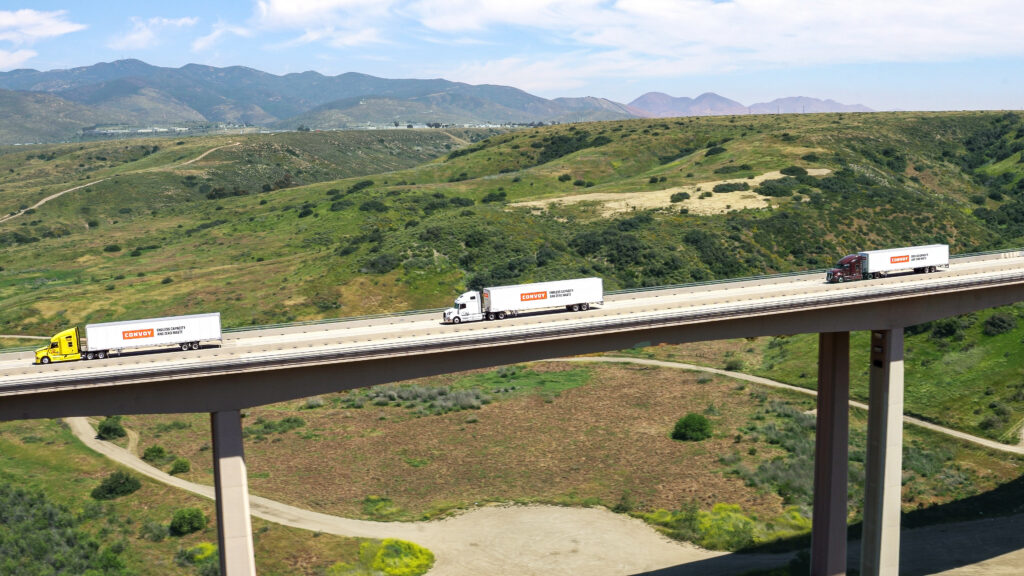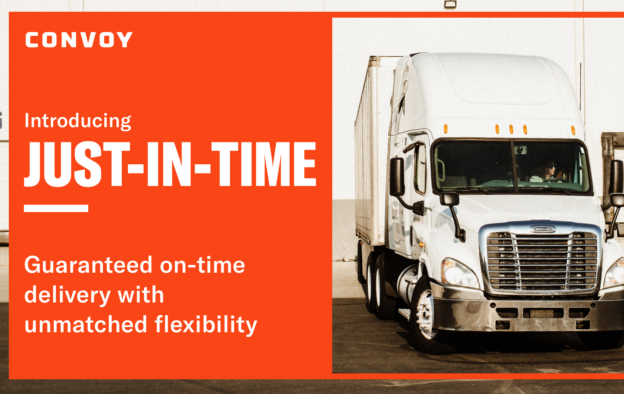America Needs a Digital Supply Chain and Trucking is Next
Carriers, Convoy News, Shippers, Sustainability • Published on April 21, 2022
There’s no turning back – the $1 trillion trucking industry is going digital

Over the next decade, the $1 trillion that companies spend each year to truck freight around the country will shift from traditional, offline approaches to digital-first strategies. These smart systems are easy to use, full of rich data insights, and optimized by machine learning algorithms. This pattern of digitization has played out in nearly every other industry, and it’s happening in trucking right now.
The trucking industry links more than 100,000 shippers across the domestic supply chain with a diverse base of more than 1 million carriers and 3 million drivers. It operates in silos with minimal data, opaque pricing, millions of empty miles, and lots of waiting around. This system no longer keeps up with the dynamic requirements of a healthy supply chain.
Trucking is shifting to connected, transparent, and data-rich systems that efficiently orchestrate across shippers, carriers, drivers, trucks, trailers, docks, yards, and more. Carriers and drivers experience higher truck utilization, fewer empty miles, and less wasted time. Shippers benefit with better reporting, more visibility, and real-time pricing and decision-making at lower total costs.
Freight Trucking in the New Digital Supply Chain
Convoy has spent the last seven years building this future of trucking for our customers by connecting small carriers and owner-operators onto a digital platform. This unique access to capacity and a rich stream of data for every load allows us to rethink how we run our trucking services and leads to countless innovations. We aren’t letting up anytime soon, and our recent announcement shows that some of the best investors in the world are behind us. Here are six critical areas in the transition to digitally-driven freight solutions.
1. True elastic capacity
2. Guaranteed coverage for contract freight
3. Democratizing access to freight to maximize efficiency – all carriers and owner-operators available for all freight
4. Reducing total costs with the data and insights generated from transportation
5. A ‘No empty miles’ mindset
6. Self-driving trucks teaming up with human drivers
1. True elastic shipping capacity
The one thing we can always count on in a complex supply chain is volatility. Whether it’s a backed-up facility, a swing in demand, moves outside normal patterns, or a new phase of the freight market cycle, transportation teams are constantly working to maintain access to high-quality service, reliable capacity, and fair prices.
We have invested in creating true elasticity — the real-time ability to dynamically activate trucks, trailers, and drivers to match needs — to provide a high level of service to customers and absorb the swings they experience in their business. For example, over the past several years, our Convoy Go program has become the most flexible drop & hook trailer option on the market. To achieve this, we use technology to continually analyze the number of trailers customers need at a given facility to satisfy upcoming loads. Our systems automatically route and rebalance thousands of trailers and trucks across a geography to ensure customers always have what they need. This elasticity lets facilities operate at peak efficiency, despite unexpected levels of demand.
The investments we’ve made over the last seven years – in more than 50 machine learning models, predictive trailer routing, and automated backup and spot services for drop freight – provide the foundation for this future, enabling transportation teams to quickly flex their capacity in ways never before possible.
2. Guaranteed coverage for contract freight
In a fragmented industry where freight capacity and service levels are inconsistent, shippers maintain relationships and solicit bids from dozens or even hundreds of carriers to have redundant options, even in a small region or lane. Despite this significant undertaking, coverage can still be unreliable, and reacting to routing guide failure is a regular challenge for every transportation team.
It’s critical that guaranteed coverage and its game-changing benefits become a reality for shippers. Coverage failures would become rare, dramatically simplifying procurement and operations. Systems would become more tightly integrated, and processes at facilities like dock scheduling and loading would be optimized. All of this would result in significant savings on the total cost of freight.
At Convoy, we operate a network that reaches tens of thousands of owner-operators and small trucking companies every day — fully automated and more extensive than the traditional approach. Through this network, Convoy can match the needs of our customers in any market condition. Customers adopting Convoy’s Guaranteed Primary program are already receiving these benefits today, including keeping products on shelves, transparent pricing, and cost savings.
Over the last 18 months, market volatility in freight RFPs has accelerated the shift toward this future state. Freight providers increasingly offer alternatives to the standard freight RFP tools and processes, and shippers are adopting dynamic pricing programs with guaranteed coverage, including Convoy’s Guaranteed Primary and Dynamic Backup.
3. Democratize access to freight to maximize efficiency – all carriers and owner-operators available for all freight
90% of trucking companies have fewer than six trucks and hundreds of thousands of drivers are owner-operators of their own rigs. These entrepreneurs are the backbone of the American supply chain, yet they face challenges not shared by larger counterparts: lack of access to consistent freight and high-quality, high-volume loads from national shippers, an inability to secure efficient drop and hook freight, or attractive dedicated or contracted runs, and opaque or unfair financial treatment.
As more small carriers and owner-operators use technology platforms to plug into freight opportunities and plan their schedules, they will gain access to the same opportunities and safeguards as large trucking companies. Convoy’s app empowers drivers to service loads from the largest shippers, proactively plan their routes to know when they’ll be home with their families, and lets drivers create schedules that keep their truck full and earnings predictable. It’s still early; there is much more potential to help drivers and small businesses make decisions on the options that impact them most.
Since 2015, Convoy has been building toward this future. Programs like Convoy Go provide small carriers with access to more efficient and lucrative power-only loads. Hassle-Free Detention and QuickPay™ help carriers get paid quickly and easily. TruckYeah Savings provides financial economies of scale that enable carriers to save on fuel, factoring, and equipment. And through Convoy for Brokers, carriers have more ways to maximize utilization with loads from other 3PLs that have adopted Convoy’s platform to cover their demand.
4. Reducing total costs with the data and insights generated from transportation
The data and insights generated through freight transportation create substantial value beyond the transportation of goods. Transportation teams increasingly rely on insights gathered from analyzing tender practices, facility operations, driver feedback, and more to increase efficiency and drive down costs. These insights are just the tip of the iceberg.
Digital freight networks like Convoy have systems orchestrating every step of the shipment lifecycle with real-time connectivity from tenders and spot boards to the inside of trailers and the cab of each truck. There is incredible potential to optimize inventory, warehouses, orders, and more by providing quick and accurate signals through real-time APIs, not human transcription.
Today, some of Convoy’s customers run their daily list of orders through our systems, where we use our signals to consolidate orders into fewer trucks and more efficient routes with lower total costs. This is one benefit of dozens our industry will unlock in the years ahead.
5. Support sustainability in freight transport with a ‘No empty miles’ mindset
Waste benefits no one — it’s bad for carriers, shippers, and the environment. Today, 90% of S&P 500 companies invest in and report annual corporate sustainability goals, up from 20% a decade ago. In March, the SEC announced a climate disclosure proposal tying greenhouse gas emissions and indirect emissions to risk management. As sustainability continues to gain momentum in modern business practices, freight logistics represents a massive, largely untapped opportunity in sustainability.
With 35% of all heavy-duty truck miles still being driven empty, technology-driven freight operations will become a meaningful and measurable contributor to companies’ sustainability goals. If the industry can achieve the same efficiency improvements that Convoy has seen on bundled shipments, which was shown to reduce the average empty miles of participating carriers from 36% to 19% (a 45% reduction), it would reduce carbon emissions by 40 million metric tons annually. That’s the equivalent of taking more than 8.6 million passenger vehicles off the road.
Since our founding in 2015, Convoy has been a pioneer in sustainable freight. We’re leading the transformation toward a more sustainable future of freight through investments in technology like automated reloads, multi-load batching, and efficient appointment windows.
6. Self-driving trucks team up with human drivers
The mainstream adoption of self-driving trucks is many years away. As autonomous driving technology matures, the first way this technology will benefit the industry is by allowing trucks to run longer than the current limit of 11 hours of service per day that drivers must follow. Drivers will remain in the truck, but be able to hand off navigating the highway portions to the vehicle so that the human driver can go off-duty, rest, and reset their service hours (read more about my thoughts on self-driving trucks and human drivers here).
As self-driving trucks enter the market, we will see years of mixed fleets containing traditional and autonomous trucks of varying degrees, as well as mixed rules and regulations for fleet operators to follow. Whether a truck can drive autonomously will vary by its load, technology, location, current weather conditions, traffic situations, etc. Doing this effectively will require technology and techniques like machine learning and AI to consider these variables and optimize. This will be a significant opportunity for Convoy and an exciting area to partner in.
This shift in fleet management is a natural fit for digital freight networks like Convoy. The machine learning investments we’ve made in automated brokering and asset rebalancing are the foundation to managing the mixed fleets of the future.
The road ahead
This change is happening today, and I’m grateful for all our stakeholders’ involvement. To our drivers, dispatchers, transportation planners, logistics managers, procurement officers, supply chain executives, brokers, and partners – your insights and feedback continue to drive the work we do every day.



